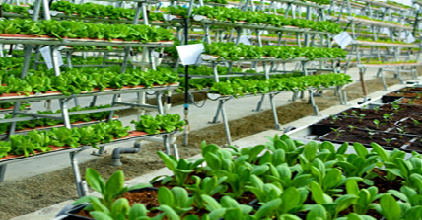 enquiry@ajaybio.in
enquiry@ajaybio.in Call Us: 020-67111010
Call Us: 020-67111010
Vertical farming is the practice of producing crops in vertically stacked layers, vertically inclined surfaces and/or integrated in other structures (such as in a skyscraper, used warehouse, or shipping container). The modern ideas of vertical farming use indoor farming techniques and controlled environmental Agriculture (CEA) technology, where all environmental factors can be controlled. These facilities utilize artificial control of light, environmental control (humidity, temperature, gases...) and fertigation. Some vertical farms use techniques similar to greenhouses, where natural sunlight can be augmented with artificial lightening and metal reflectors.

Indoor urban farming through the establishment of vertical farms (or high-rise farms) in urban centres is the likely solution to the swelling human population. The argument in favour of this technology in relation to food security is convincing, plus it has plenty more benefits too. The world population will increase from about 6.9 billion in 2010 to 9.2 billion in 2050 or an addition of about 2.3 billion more people to feed. The percentage of urban population will likewise increase from 50.46% in 2010 to 68.70% in 2050. It is expected that world population will continue to increase. Currently, the rate of growth per year is about 80 million.
Increased and Year-round Crop Production. This farming technology can ensure crop production all year-round in non-tropical regions. 1 indoor acre is equivalent to 4-6 outdoor acres or more, depending on the crop. For strawberries, 1 indoor acre may produce yield equivalent to 30 acres. Indoor farming will minimize infestation and post-harvest spoilage.
Weather-Related Problems:
Will be safe from extreme weather occurrences such as droughts and floods.

This method can be further exploited for large scale production of organic crops. The controlled growing conditions will allow a reduction or total abandonment of the use of chemical pesticides.
Water Conservation and Recycling:
The vertical farming technology includes hydroponics which uses 70 percent lesser water than normal agriculture.

Every land area that will be developed for this farming technology will reduce by a hundred-fold the necessity of utilizing land for food production. These farms could be reverted to their natural state. This will promote the regrowth of trees in these areas.
Sustainable Urban Growth:
Vertical farming, applied in a holistic approach in conjunction with other technologies, can allow urban areas to absorb the expected influx of more population and yet still remain food sufficient.
Biofix offer a range on Biofix biofertilizers, Biofix biopesticides, Biofix Bio fungicides , Biofix Plant growth stimulants and Biofix micronutrients which can help in maintaining the vertical Farming and also help in its grow and flourish.
